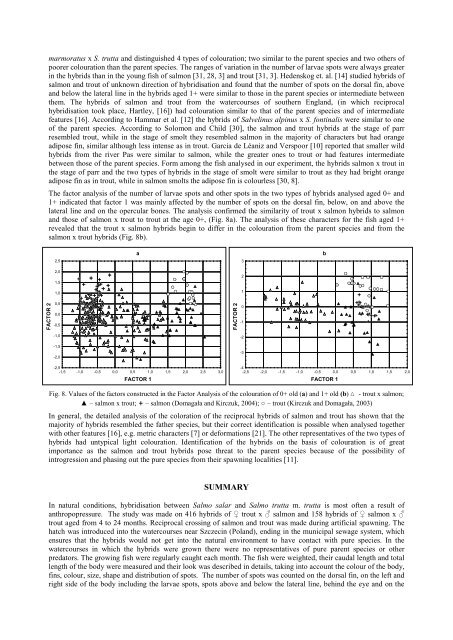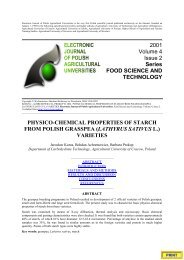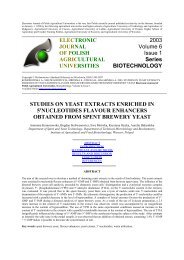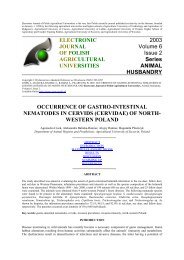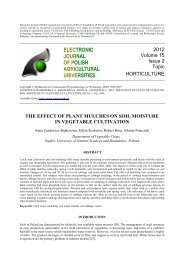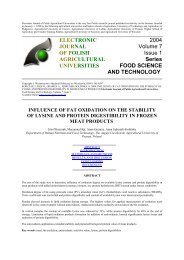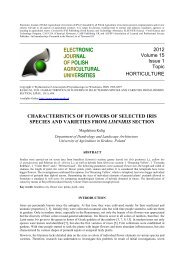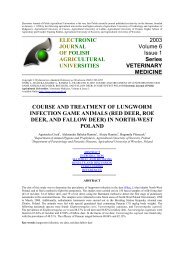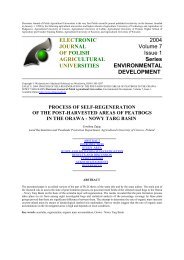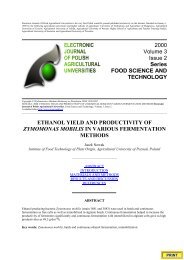marmoratus x S. trutta and distinguished 4 types <strong>of</strong> colouration; two similar to the parent species and two others <strong>of</strong>poorer colouration than the parent species. The ranges <strong>of</strong> variation in the number <strong>of</strong> larvae spots were always greaterin the hybrids than in the young fish <strong>of</strong> <strong>salmo</strong>n [31, 28, 3] and trout [31, 3]. Hedenskog et. al. [14] studied hybrids <strong>of</strong><strong>salmo</strong>n and trout <strong>of</strong> unknown direction <strong>of</strong> hybridisation and found that the number <strong>of</strong> spots on the dorsal fin, aboveand below the lateral line in the hybrids aged 1+ were similar to those in the parent species or intermediate betweenthem. The hybrids <strong>of</strong> <strong>salmo</strong>n and trout from the watercourses <strong>of</strong> southern England, (in which reciprocalhybridisation took place, Hartley, [16]) had colouration similar to that <strong>of</strong> the parent species and <strong>of</strong> intermediatefeatures [16]. According to Hammar et al. [12] the hybrids <strong>of</strong> Salvelinus alpinus x S. fontinalis were similar to one<strong>of</strong> the parent species. According to Solomon and Child [30], the <strong>salmo</strong>n and trout hybrids at the stage <strong>of</strong> parrresembled trout, while in the stage <strong>of</strong> smolt they resembled <strong>salmo</strong>n in the majority <strong>of</strong> characters but had orangeadipose fin, similar although less intense as in trout. Garcia de Léaniz and Verspoor [10] reported that smaller wildhybrids from the river Pas were similar to <strong>salmo</strong>n, while the greater ones to trout or had features intermediatebetween those <strong>of</strong> the parent species. Form among the fish analysed in our experiment, the hybrids <strong>salmo</strong>n x trout inthe stage <strong>of</strong> parr and the two types <strong>of</strong> hybrids in the stage <strong>of</strong> smolt were similar to trout as they had bright orangeadipose fin as in trout, while in <strong>salmo</strong>n smolts the adipose fin is colourless [30, 8].The factor analysis <strong>of</strong> the number <strong>of</strong> larvae spots and other spots in the two types <strong>of</strong> hybrids analysed aged 0+ and1+ indicated that factor 1 was mainly affected by the number <strong>of</strong> spots on the dorsal fin, below, on and above thelateral line and on the opercular bones. The analysis confirmed the similarity <strong>of</strong> trout x <strong>salmo</strong>n hybrids to <strong>salmo</strong>nand those <strong>of</strong> <strong>salmo</strong>n x trout to trout at the age 0+, (Fig. 8a). The analysis <strong>of</strong> these characters for the fish aged 1+revealed that the trout x <strong>salmo</strong>n hybrids begin to differ in the colouration from the parent species and from the<strong>salmo</strong>n x trout hybrids (Fig. 8b).2,5a3b2,01,51,021FACTOR 20,50,0-0,5FACTOR 20-1-1,0-1,5-2,0-2,5-1,5 -1,0 -0,5 0,0 0,5 1,0 1,5 2,0 2,5 3,0FACTOR 1-2-3-4-2,5 -2,0 -1,5 -1,0 -0,5 0,0 0,5 1,0 1,5 2,0FACTOR 1Fig. 8. Values <strong>of</strong> the factors constructed in the Factor Analysis <strong>of</strong> the colouration <strong>of</strong> 0+ old (a) and 1+ old (b) ∆ - trout x <strong>salmo</strong>n;▲ – <strong>salmo</strong>n x trout; + – <strong>salmo</strong>n (Domagała and Kirczuk, 2004); ○ – trout (Kirczuk and Domagała, 2003)In general, the detailed analysis <strong>of</strong> the coloration <strong>of</strong> the reciprocal hybrids <strong>of</strong> <strong>salmo</strong>n and trout has shown that themajority <strong>of</strong> hybrids resembled the father species, but their correct identification is possible when analysed togetherwith other features [16], e.g. metric characters [7] or deformations [21]. The other representatives <strong>of</strong> the two types <strong>of</strong>hybrids had untypical light colouration. Identification <strong>of</strong> the hybrids on the basis <strong>of</strong> colouration is <strong>of</strong> greatimportance as the <strong>salmo</strong>n and trout hybrids pose threat to the parent species because <strong>of</strong> the possibility <strong>of</strong>introgression and phasing out the pure species from their spawning localities [11].SUMMARYIn natural conditions, hybridisation between Salmo <strong>salar</strong> and Salmo trutta m. trutta is most <strong>of</strong>ten a result <strong>of</strong>anthropopressure. The study was made on 416 hybrids <strong>of</strong> ♀ trout x ♂ <strong>salmo</strong>n and 158 hybrids <strong>of</strong> ♀ <strong>salmo</strong>n x ♂trout aged from 4 to 24 months. Reciprocal crossing <strong>of</strong> <strong>salmo</strong>n and trout was made during artificial spawning. Thehatch was introduced into the watercourses near Szczecin (Poland), ending in the municipal sewage system, whichensures that the hybrids would not get into the natural environment to have contact with pure species. In thewatercourses in which the hybrids were grown there were no representatives <strong>of</strong> pure parent species or otherpredators. The growing fish were regularly caught each month. The fish were weighted, their caudal length and totallength <strong>of</strong> the body were measured and their look was described in details, taking into account the colour <strong>of</strong> the body,fins, colour, size, shape and distribution <strong>of</strong> spots. The number <strong>of</strong> spots was counted on the dorsal fin, on the left andright side <strong>of</strong> the body including the larvae spots, spots above and below the lateral line, behind the eye and on the
opercular bones. As far as colouration is concerned, the ♀ trout x ♂ <strong>salmo</strong>n hybrids aged 0+ and 1+ were found toresemble <strong>salmo</strong>n <strong>of</strong> the same age (similar number <strong>of</strong> spots above and below the lateral line and on the opercularbones, and the spots below the lateral line reached the distance marked by the end <strong>of</strong> the dorsal fin). The <strong>salmo</strong>n x ♂trout hybrids resembled trout, but the ranges <strong>of</strong> variation <strong>of</strong> individual features were greater than in trout. Thehybrids <strong>of</strong> the two types differed from the parent species in the greater ranges <strong>of</strong> variation <strong>of</strong> particular characters,irregular distribution <strong>of</strong> spots, brighter colours and irregular shapes <strong>of</strong> larval spots and other spots. Some hybridsrepresenting the two types had untypical lighter colouration with larval spots only or with additional few little spots.REFERENCES1. Alm G., 1955. Artificial hybridization between different species <strong>of</strong> the Salmon family. Inst. Freshwater Res. DrottningholmReport 36,13-56.2. Beall E., Moran P., Pendas A., Izquierdo J., Garcia-Vazquez E., 1997. L’hybridation dans les populations naturelles deSalmonidés dans le sud-ouest de L’Europe ET en milieu experimental. Bull. Fr. Pêche Piscic., 344/345, 271-285.3. Brylińska M., 2000. Freshwater fish <strong>of</strong> Poland. Warszawa, PWN. 521 p.[In <strong>Polish</strong>].4. Campton D.E., Uter F.M., 1987. Genetic structure <strong>of</strong> anadromous cutthroat trout (Salmo clarki clarki) in two Puget Soundstreams. Can. J. Fish. Aquat. Sci., 42, 110-119.5. Chevassus B. 1979. Hybridization in Salmonids: results and perspectives. Aquacult., 17, 113-128.6. Crozier W.W., 1984. Electrophoretic identification and comparative examination <strong>of</strong> naturally occurring F 1 hybrids betweenbrown trout (Salmo trutta L.) and Atlantic <strong>salmo</strong>n (S. <strong>salar</strong> L.). Comp. Biochem. Physiol., 78B: 785-790.7. Delling B., Crivelli A.J., Rubin J-F., Berrebi P., 2000. Morphological variation in hybrids between Salmo marmoratus andalien Salmo species in the Volarja stream, Soca River basin, Slovenia. J. Fish Biol., 57, 1199-1212.8. Domagała J., Kirczuk L., 2004. Morphological characterisation <strong>of</strong> <strong>salmo</strong>n (Salmo <strong>salar</strong> L., <strong>1758</strong>) aged 0+, 1+ and 2+,stocked in Pomeranian rivers. Electron. Pol. Agric. Univ., Fisheries. Vol. 7, Issue 1 (www.ejpau.media.pl).9. Elo K., Erkinaro J., Vuorinen J., Niemela E., 1995. Hybridization between Atlantic <strong>salmo</strong>n (Salmo <strong>salar</strong>) and brown trout (S.trutta) in the Teno and Näätämö River Systems, northernmost Europe. Nordic. J. Freshw. Res., 70, 56-61.10. Garcia de Léaniz C., Verspoor E., 1989. Natural hybridization between Atlantic <strong>salmo</strong>n, Salmo <strong>salar</strong>, and brown trout, Salmotrutta, in northern Spain. J. Fish Biol., 34, 41-46.11. Garcia-Vazquez E., Ayllon F., Martinez J., Perez, J., Beall E., 2003. Reproduction <strong>of</strong> interspecific hybrids <strong>of</strong> Atlantic <strong>salmo</strong>nand brown trout in a stream enviroment. Fresh. Biol., 48,1100-1104.12. Hammar J., Dempson J.B., Verspoor E., 1991. Natural Hybridization between Arctic Char (Salvelinus alpinus) and BrookTrout (Salvelinus fontinalis): Evidence from Northern Labrador. Can. J. Fish. Aquat. Sci., 48, 1437-1445.13. Hartley S.E., 1996. High incidence <strong>of</strong> Atlantic <strong>salmo</strong>n x brown trout hybrids in a Lake District stream. J. Fish Biol., 48, 151-154.14. Hedenskog M., Petersson E., Järvi T., Khamis M., 1997. Morphological Comparison <strong>of</strong> Natural Produced Atlantic Salmon(Salmo <strong>salar</strong> L.), Anadromous Brown Trout (S.. trutta L.), and their Hybrids. Nordic. J. Freshw. Res., 73, 35-43.15. Hubbs C.L. 1955. Hybridization between Fish Species in Nature. Syst. Zool., 1-20.16. Hurrell R.H., Price D.J., 1991. Natural hybrids between Atlantic <strong>salmo</strong>n, Salmo <strong>salar</strong> L., and brown trout, Salmo trutta L., injuvenile <strong>salmo</strong>nid populations in south-west England. J. Fish Biol., (Suppl. A) 39, 335-341.17. Jansson H., Öst T., 1997. Hybridization between Atlantic <strong>salmo</strong>n (Salmo <strong>salar</strong>) and brown trout (Salmo trutta) in a restoredsection <strong>of</strong> the River Dalälven, Sweden. Can. J. Fish. Aquat. Sci., 54, 2033-2039.18. Jones J.W., 1947. Salmon and trout hybrids. Proc. zool. Soc. London, 117, 708-715.19. Jordan W.C., Verspoor E., 1993. Incidence <strong>of</strong> natural hybrids between Atlantic <strong>salmo</strong>n, Salmo <strong>salar</strong> L., and brown trout, S.trutta L., in Britain. Aquacult. Fish. Manage., 24, 373-377.20. Kirczuk L., Domagała J., 2003. Characteristics <strong>of</strong> young sea trout (Salmo trutta m. trutta L. <strong>1758</strong>) growing in Pomeranianrivers to the smolt stage. Electron. Pol. Agric. Univ., Fisheries., Vol. 6, Issue 1 (www.ejpau.media.pl).21. Kirczuk L., Domagała J., 2009. Deformations in reciprocal hybrids <strong>of</strong> <strong>salmo</strong>n (Salmo <strong>salar</strong> L., <strong>1758</strong>) and trout (Salmo truttam. trutta L., <strong>1758</strong>) aged 0+ and 1+. Bull. Eur. Ass. Fish Pathol. 29(5): 47-55.22. Kuzyshchyn K.B., Machrov A.A., Novikov G.G., 1998. Morphological peculiarities <strong>of</strong> the trout Salmo trutta L. from waterbodies <strong>of</strong> Vielikaya Salma (Karelian White Sea coast). Salmonid problems in Northern Europe]. Russkaja AN. KarielskiïNaucznyï Centr Petrozavodsk, 2, 31-51.23. Makhrov A.A., Kuzishchin, K.V., Novikov G.G. 1998. Natural hybrids <strong>of</strong> Salmo <strong>salar</strong> with Salmo trutta in the rivers <strong>of</strong> theWhite Sea Basin. Jour. Ichthyol., 38(1), 61-66.24. McGowan C., Davidson W.S. 1992. Artificial hybridization <strong>of</strong> Newfoundland brown trout and Atlantic <strong>salmo</strong>n: hatchability,survival and growth to first feeding. Aquacult., 106, 117-125.25. Nyman L. 1970. Electrophoretic analysis <strong>of</strong> hybrids between <strong>salmo</strong>n (Salmo <strong>salar</strong> L.) and trout (Salmo trutta L.). Trans.Amer. Fish. Soc., 99, 1, 229- 236.26. Payne R.H., Child A.R., Forrest A., 1972. The existence <strong>of</strong> natural hybrids between the European trout and the Atlantic<strong>salmo</strong>n. J. Fish Biol., 4, 233-236.27. Piggins D.J. 1964. Salmon and sea trout hybrids. ICES. Salmon and Trout Committee, Paper no. C. M. 1964/5028. Schmidt, G., 1996. Wiedereinbürgerung des Lachses Salmo <strong>salar</strong> L. in Nordrhein-Westfalen- Allgemeine Biologie desLachses sowie Konzeption und Stand des Wiedereinbürgerungsprogramms unter besonderer Berücksichtigungder Sieg.Landwirtchaftsverlag GmbH, Münster. 9-124 pp.29. Semenova S.K., Slyn’ko V.I., 1988. Protein Polymorphism in Salmo <strong>salar</strong> L. and Salmo trutta L. Populations and theirHybrids. Genetika 24, (3) 548-555.
- Page 1: Electronic Journal of Polish Agricu
- Page 4 and 5: 10,0a4,0b9,53,5spots number9,08,58,
- Page 6 and 7: the eye on the left side of the bod
- Page 10: 30. Solomon, D.J., Child A.R., 1978


